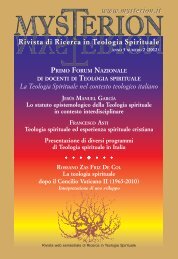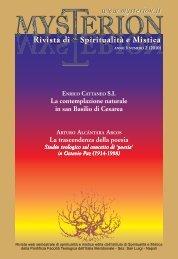Mysterion - rivista di spiritualità e mistica
Mysterion - rivista di spiritualità e mistica
Mysterion - rivista di spiritualità e mistica
Create successful ePaper yourself
Turn your PDF publications into a flip-book with our unique Google optimized e-Paper software.
www.MYS ERION.it<br />
W.R. STOEGER S.J.<br />
66<br />
1 (2008) 64-77<br />
imme<strong>di</strong>ate ancestral primates for about four million years. Multi-cellular organisms have<br />
been around for only about a billion years. Before that there was only primitive plants,<br />
plankton and one-celled organisms. Earlier than about 3.9 billion years there was no life<br />
at all on Earth. Earlier than 5 billion years ago the Sun and the Earth <strong>di</strong>d not exist.<br />
But there were other stars before our Sun which manufactured all the heavy elements<br />
(elements heavier than hydrogen and helium) of which our earth, all life and we ourselves<br />
are composed. So there was an time when there were no elements besides hydrogen,<br />
helium and a very little bit of lithium, the lightest metal. In fact, we know for sure that<br />
there was a time – the first several hundred million years after the Big Bang, when there<br />
were no stars or galaxies at all. Things were very <strong>di</strong>fferent, and life was not yet possible.<br />
In fact for the first 300,000 years after the Big Bang, the universe was just an expan<strong>di</strong>ng,<br />
gradually cooling ball of hot ionized gas – very smooth and with practically no lumps in<br />
it. Fortunately for us, there were very slight over-densities and under-densities – we call<br />
them perturbations – in the hot ionized gas. Once the temperature of the universe fell<br />
below about 4,000 K, the electrons and protons and neutrons in the hot gas combined<br />
to form neutron hydrogen and helium atoms, the gas decoupled from the ra<strong>di</strong>ation in<br />
the universe, and for the first time the slight over-densities in the gas (overdensities of<br />
about 1 part in 100,000) began to grow. Only after hundreds of millions of years would<br />
they eventually collapse and fragment to form the first galaxies and stars. Only then<br />
were the carbon, oxygen, copper, phosphorous, iron, nitrogen and all the other heavier<br />
elements produced. Gradually – very gradually – the necessary components for the rich<br />
molecular me<strong>di</strong>ums essential for the emergence of life were being generated.<br />
The picture which emerges from observational cosmology and astronomy is very<br />
simple and straightforward. At the Big Bang, about 13.7 billion years ago, the universe<br />
was very, very hot – T> 1032K – so hot that not even space and time as we know them<br />
could exist, much less particles or any structure. In fact we do not have anything even<br />
approaching an adequate physical description of this extreme state. A quantum theory<br />
of gravity is needed. But imme<strong>di</strong>ately after the Big Bang, the universe – as just a homogeneous<br />
spherically symmetric ball of super-hot mass-energy – began to expand and<br />
cool quite rapidly. And as it cooled new things became possible. The lower the temperature,<br />
the more laws of nature themselves and the matter and energy they describe could<br />
<strong>di</strong>fferentiate and complexity. As an example, much later, as we have already seen, the<br />
cosmic plasma was cool enough to clump into stars, galaxies and clusters of galaxies,<br />
and to organize itself into particles, atoms and primitive molecules. Thus, at the beginning<br />
the universe is very hot, very dense, very smooth, very simple and very un<strong>di</strong>fferentiated.<br />
As it expands, it cools, become more lumpy, more complex, and more<br />
<strong>di</strong>fferentiated. The very fact that it fragments and condenses into hundreds of billions<br />
of galaxies and trillions of stars essentially means that trillions of separate evolutionary<br />
experiments are being carried out at the same time – each star and each planet in the<br />
universe is a separate, relatively isolated location where physical, chemical, and in some<br />
cases possibly biological evolution occurs.<br />
How do we know that this scenario of cosmic evolution is correct? What is the<br />
evidence for it? There are three major independent in<strong>di</strong>cations. The first is the systematic<br />
redshifts of <strong>di</strong>stant galaxies, first <strong>di</strong>scovered by Edwin Hubble and his colleague M.







